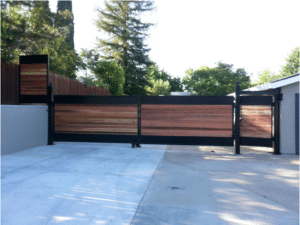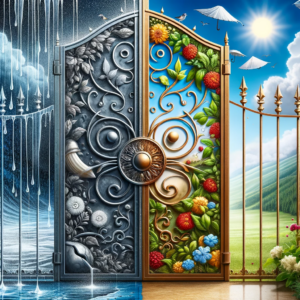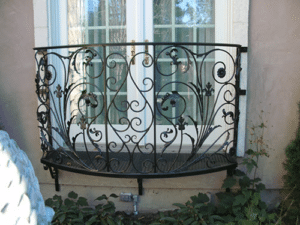Iron fencing has long been admired for its blend of utility and artistry, tracing its roots back to ancient civilizations where it symbolized strength and elegance. Over centuries, the craft evolved, giving rise to master craftsmen who dedicate their lives to perfecting the intricate designs and techniques that define the art of iron fencing.
The Legacy of Iron Fencing Craftsmanship
The history of iron fencing is rich with cultural significance, evolving from simple barriers to ornate works of art that adorn landmarks and estates. Master craftsmen play a crucial role in this evolution, preserving age-old techniques while also innovating to meet contemporary tastes. Their expertise ensures that the art of iron fencing remains a vibrant and respected craft.
Profiles of Renowned Master Craftsmen
Craftsman 1: Villi Zanini Villi Zanini is an Italian master craftsman renowned for his exceptional work in wrought iron. Based in Treviso, Italy, Zanini has dedicated his life to creating custom ironwork for private homes, hotels, and prestigious buildings worldwide. His unique approach blends traditional hand-forging techniques with modern rendering tools, allowing him to maintain the classical aesthetic of ironwork while innovating with contemporary designs. Some of his most notable projects include intricate gates, railings, and custom decorative elements that showcase his meticulous attention to detail and artistic vision(Italia Living).
Craftsman 2: Philip Simmons Philip Simmons was a legendary blacksmith from Charleston, South Carolina, whose work has become synonymous with the city’s historic charm. Over his career, Simmons designed and forged over 500 wrought iron pieces, including fences, gates, and balconies, many of which are now iconic features of Charleston’s architectural landscape. Simmons began his career as an apprentice at the age of 12 and quickly developed a reputation for his ability to blend traditional craftsmanship with artistic creativity. His contributions to the art of ironwork earned him numerous accolades, including the National Heritage Fellowship and a place in the South Carolina Hall of Fame. His legacy continues through his family, who maintain his workshop and share his craft with new generations(The Jasper).
Craftsman 3: Compass Ironworks Compass Ironworks, a family-owned and operated shop established in 1998, is a modern embodiment of traditional ironworking skills. The craftsmen at Compass Ironworks are known for their meticulous attention to historical details and their ability to restore and recreate the intricate designs of past masters. Their work often involves collaborations with designers and architects to create custom iron gates, fences, and railings that respect historical authenticity while integrating modern durability. This blend of old-world craftsmanship and contemporary innovation has made Compass Ironworks a respected name in the industry, contributing significantly to the preservation and evolution of ironwork art (
Techniques and Materials
The art of iron fencing relies heavily on both traditional and modern techniques, each bringing a unique flavor to the craft. Traditional methods, such as hand-forging, involve heating iron in a forge until it is malleable enough to be hammered into intricate designs. This process, still practiced by master craftsmen like Philip Simmons, requires a deep understanding of metal properties and a high level of skill to produce the elegant curves and detailed motifs that characterize historic ironwork.
In contrast, contemporary artisans like Villi Zanini integrate modern tools, such as computer-aided design (CAD) software and rendering techniques, to enhance precision and efficiency. These tools allow for more complex and customized designs, bridging the gap between tradition and innovation. Despite these advancements, the fundamental process of shaping and assembling iron remains largely unchanged, preserving the authenticity of the craft.
Materials play a crucial role in the quality and longevity of iron fences. While wrought iron is the traditional choice due to its malleability and durability, modern craftsmen also use mild steel, which offers similar properties at a lower cost. High-quality materials, combined with techniques such as hot-dip galvanizing and powder coating, ensure that the ironwork withstands the test of time and the elements.
Notable Projects and Contributions
Each master craftsman has left an indelible mark on the world of iron fencing through their notable projects. Philip Simmons, for instance, is celebrated for his work throughout Charleston, South Carolina. His iconic pieces, such as the ornate gates at the Charleston International Airport and the intricate railings at Liberty Square, are not just functional but are revered as works of art, contributing significantly to the city’s historical and cultural heritage.
Villi Zanini’s contributions are similarly impressive, with custom ironwork adorning luxurious private residences and prestigious public buildings across Europe. His ability to fuse traditional techniques with modern design has resulted in stunning gates, balconies, and decorative elements that enhance both the aesthetics and value of the properties they adorn.
Compass Ironworks, on the other hand, has made significant strides in the restoration and recreation of historical iron fences. Their meticulous approach to maintaining historical accuracy while incorporating modern durability has earned them recognition in the preservation of architectural heritage. Their projects, which often involve collaborations with architects and designers, are a testament to the enduring beauty and relevance of iron fencing.
The Future of Iron Fencing Art
As the world of iron fencing continues to evolve, contemporary craftsmen play a crucial role in pushing the boundaries of the art. They are not only preserving traditional techniques but also experimenting with new methods and materials to meet the demands of modern architecture. This evolution is critical in ensuring that the craft remains relevant in today’s fast-paced world.
Younger generations of artisans are learning the trade through apprenticeships and formal training, where they are encouraged to innovate while respecting the craft’s rich history. The integration of digital design tools and sustainable materials reflects a growing trend towards environmentally conscious and technologically advanced ironwork. These innovations are helping to revitalize the craft, attracting a new audience who appreciate both the historical significance and the modern applications of iron fencing.
Conclusion
The art of iron fencing is a testament to the enduring appeal of craftsmanship, where tradition and innovation coexist to create works of lasting beauty. The dedication of master craftsmen like Philip Simmons, Villi Zanini, and the team at Compass Ironworks ensures that this art form continues to thrive, contributing to the cultural and architectural heritage of communities around the world.
As we admire these intricate creations, it is important to recognize and support the artisans who keep this craft alive. Their work not only enhances our built environment but also connects us to a rich history of artistic expression, where every piece of ironwork tells a story of skill, creativity, and timeless elegance.
Want beautiful wrought ion for yourself? Contact us today.



